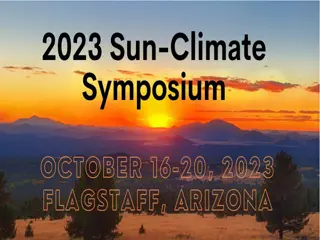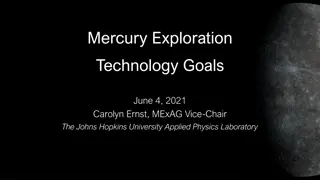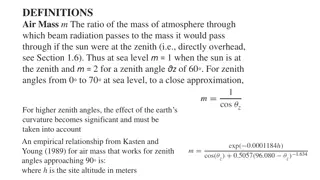IRRADIANCE
Irradiance measures the amount of light falling on a specific area, similar to calculating rainfall. Learn about the formula relating energy and time, how distance affects irradiance, and how to calculate irradiance in practical examples.
Download Presentation

Please find below an Image/Link to download the presentation.
The content on the website is provided AS IS for your information and personal use only. It may not be sold, licensed, or shared on other websites without obtaining consent from the author.If you encounter any issues during the download, it is possible that the publisher has removed the file from their server.
You are allowed to download the files provided on this website for personal or commercial use, subject to the condition that they are used lawfully. All files are the property of their respective owners.
The content on the website is provided AS IS for your information and personal use only. It may not be sold, licensed, or shared on other websites without obtaining consent from the author.
E N D
Presentation Transcript
IRRADIANCE http://tse1.mm.bing.net/th?id=OIP.Mfb1b48205e794b395e50a6deaaacf22fH0w=264h=211c=0pid=1.9rs=0p=0r=0
http://tse1.mm.bing.net/th?id=OIP.M8a5b4271e64f6eb9ec9616ee5a0433c0o1w=265h=299c=0pid=1.9rs=0p=0r=0http://tse1.mm.bing.net/th?id=OIP.M8a5b4271e64f6eb9ec9616ee5a0433c0o1w=265h=299c=0pid=1.9rs=0p=0r=0 WHAT IS IRRADIANCE? Irradiance is the unit by which we measure the amount of light falling on an area. In much the same way we might measure the amount of rainfall over Scotland: If we want to calculate average rainfall we would measure: -The volume or amount of rain -The time over which it fell -The area over which it fell Irradiance is dealt with in a similar way, you need: -The amount of energy -The time it took for that energy to fall -The area over which it falls
http://tse1.mm.bing.net/th?id=OIP.M2bb3289a671b0108985e42e6671837e7o0w=300h=299c=0pid=1.9rs=0p=0r=0http://tse1.mm.bing.net/th?id=OIP.M2bb3289a671b0108985e42e6671837e7o0w=300h=299c=0pid=1.9rs=0p=0r=0 IRRADIANCE Think back to what you know about energy and time Is there a formula that links them? ????? =?????? ???? This leads us to describe irradiance in terms of power per unit area: ?????????? =????? ???? ? (?) ? (??) ? = so the unit for I is Wm-2
Image result for note clip art IRRADIANCE Irradiance is measured in watts per metre squared (Wm-2) It is defined as the amount of energy incident on an area each second. It can be calculated as: ? =? ? Where I= irradiance (W/ m ) P= power (W) A= area (m )
Image result for note clip art EXAMPLE A laser produces 1kJ of energy in 2 minutes. If it is shone onto a 20cm by 20cm piece of card, calculate the irradiance of the laser on the card.
http://tse1.mm.bing.net/th?id=OIP.M8a5b4271e64f6eb9ec9616ee5a0433c0o1w=265h=299c=0pid=1.9rs=0p=0r=0http://tse1.mm.bing.net/th?id=OIP.M8a5b4271e64f6eb9ec9616ee5a0433c0o1w=265h=299c=0pid=1.9rs=0p=0r=0 BUT WHAT ABOUT THE DISTANCE? Is irradiance affected by distance? If we consider a source to be a point source, then the light will radiate out equally in all directions. As we get further from the source the same energy is dissipated over a much larger area.
Image result for note clip art IRRADIANCE AND DISTANCE FROM SOURCE Aim: to find the relationship between irradiance and distance from a light source Equipment: Metre stick Photodiode Voltmeter 12v bulb Power supply The voltage across the photodiode is directly proportional to the intensity of light incident on it.
Image result for note clip art IRRADIANCE AND DISTANCE FROM SOURCE Intensity of light I (V) Distance from sources d (cm) d (m ) 1/d (? ?) 0 10 20 30 40 50 60 70 80 90
http://tse1.mm.bing.net/th?id=OIP.M751f7a7c74cd28795683f96c76721be0o0w=158h=142c=0pid=1.9rs=0p=0r=0http://tse1.mm.bing.net/th?id=OIP.M751f7a7c74cd28795683f96c76721be0o0w=158h=142c=0pid=1.9rs=0p=0r=0 RESULTS: Plot graphs of I against d, I against d and I against 1/d Which graph can we draw a relationship from? V (mV) 1040 600 360 260 160 d (m) d (m ) 1/d (m ) 0.3 0.4 0.5 0.6 0.8
http://tse1.mm.bing.net/th?id=OIP.M2bb3289a671b0108985e42e6671837e7o0w=300h=299c=0pid=1.9rs=0p=0r=0http://tse1.mm.bing.net/th?id=OIP.M2bb3289a671b0108985e42e6671837e7o0w=300h=299c=0pid=1.9rs=0p=0r=0 INVERSE SQUARE LAW EXPERIMENT We can see from the graph of I against 1/d that I ? ?/?? ? ??or ? x ?? = k This gives us the formula ? = If we have data for irradiance at a particular distance from a light source we can calculate irradiance at a second distance using the formula: ?= ?? ?? ? ?? ??
Image result for note clip art IRRADIANCE & DISTANCE The Irradiance of a source decreases the further you are from it as the energy is spread over a larger area. ? 1 The Irradiance is inversely proportional to the distance squared. ?2 ? ?2 This leads to the equation: (k=constant) ? = This is known as the Inverse Square Law
Image result for note clip art INVERSE SQUARE LAW If we have data for irradiance at a particular distance from a light source we can calculate irradiance at a second distance using the formula: ?= ?? ?? ? ?? ?? Where I is irradiance (?/?2) and d is distance (m)
Image result for note clip art EXAMPLE At a distance of 1m an ultraviolet lamp has an irradiance of 4W/m . Calculate the irradiance of the same lamp when the distance is doubled.
QUESTIONS Section 7. Spectra: Irradiance & Inverse Square Law Q1-5
http://tse1.mm.bing.net/th?id=OIP.M2bb3289a671b0108985e42e6671837e7o0w=300h=299c=0pid=1.9rs=0p=0r=0http://tse1.mm.bing.net/th?id=OIP.M2bb3289a671b0108985e42e6671837e7o0w=300h=299c=0pid=1.9rs=0p=0r=0 IRRADIANCE AND PHOTONS Suppose N photons fall on an area of 1m per second. Each photon has energy: ? = ?? The total energy for N photons in 1 second is found by: ? = ??? Power is found using: ? =? ? So power of N photons in 1 second is given by ? = ??? We know that Irradiance is found using: ? =? ?
Image result for note clip art IRRADIANCE AND PHOTONS Irradiance of N photons is given by: ? =? ? ? This equation tells us that as irradiance increases, the number of photons given off each second increases.
Image result for note clip art EXAMPLE Find the number of photons per m each second if a light beam has an irradiance of 4 W/m and the photons have a frequency of 4.5x10^14 Hz.





